NRSG370 – Clinical Integration - Speciality Practice Case Study 2022
VerifiedAdded on 2022/10/13
|10
|3127
|15
AI Summary
Contribute Materials
Your contribution can guide someone’s learning journey. Share your
documents today.
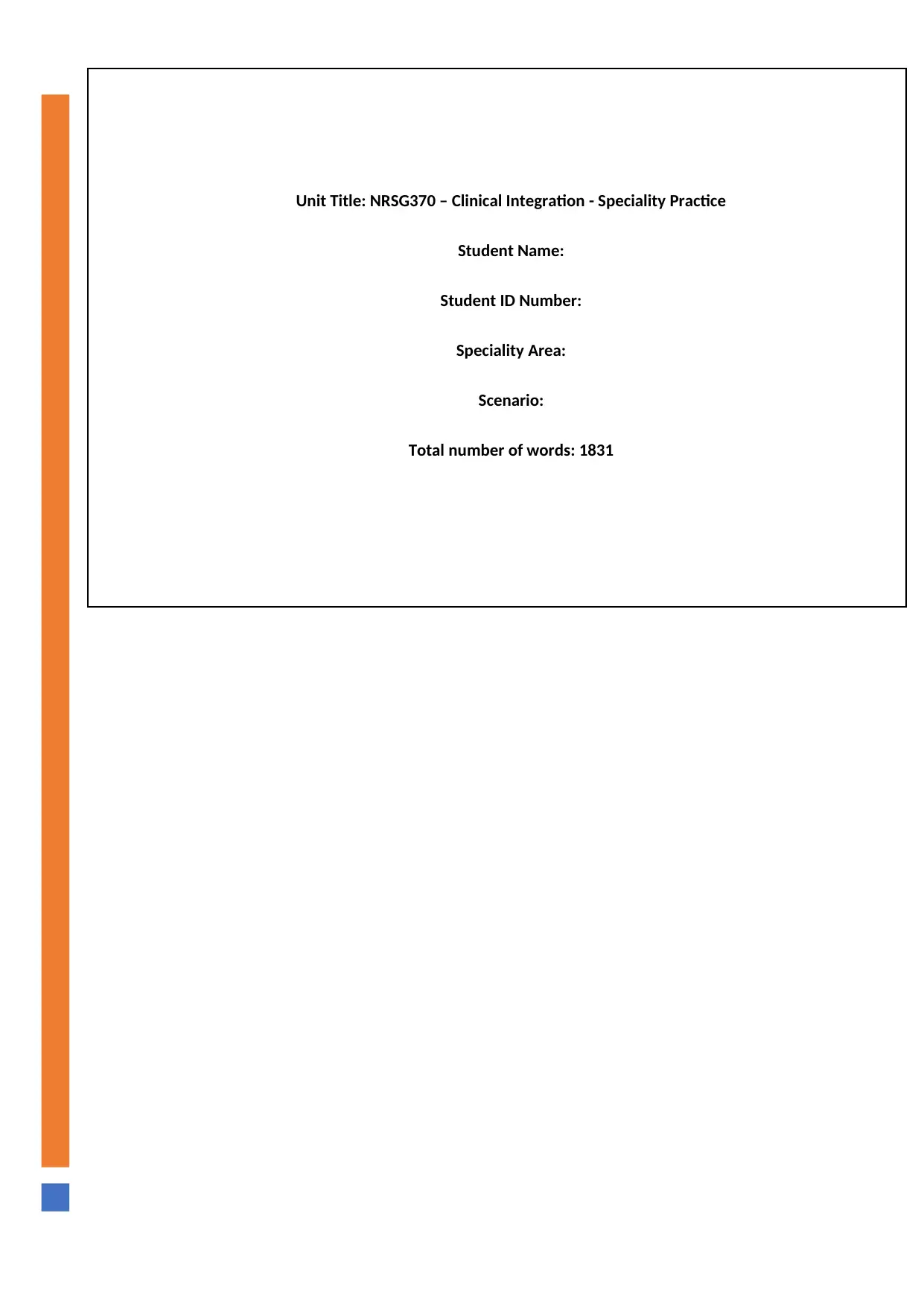
[DATE]
Unit Title: NRSG370 – Clinical Integration - Speciality Practice
Student Name:
Student ID Number:
Speciality Area:
Scenario:
Total number of words: 1831
Unit Title: NRSG370 – Clinical Integration - Speciality Practice
Student Name:
Student ID Number:
Speciality Area:
Scenario:
Total number of words: 1831
Secure Best Marks with AI Grader
Need help grading? Try our AI Grader for instant feedback on your assignments.
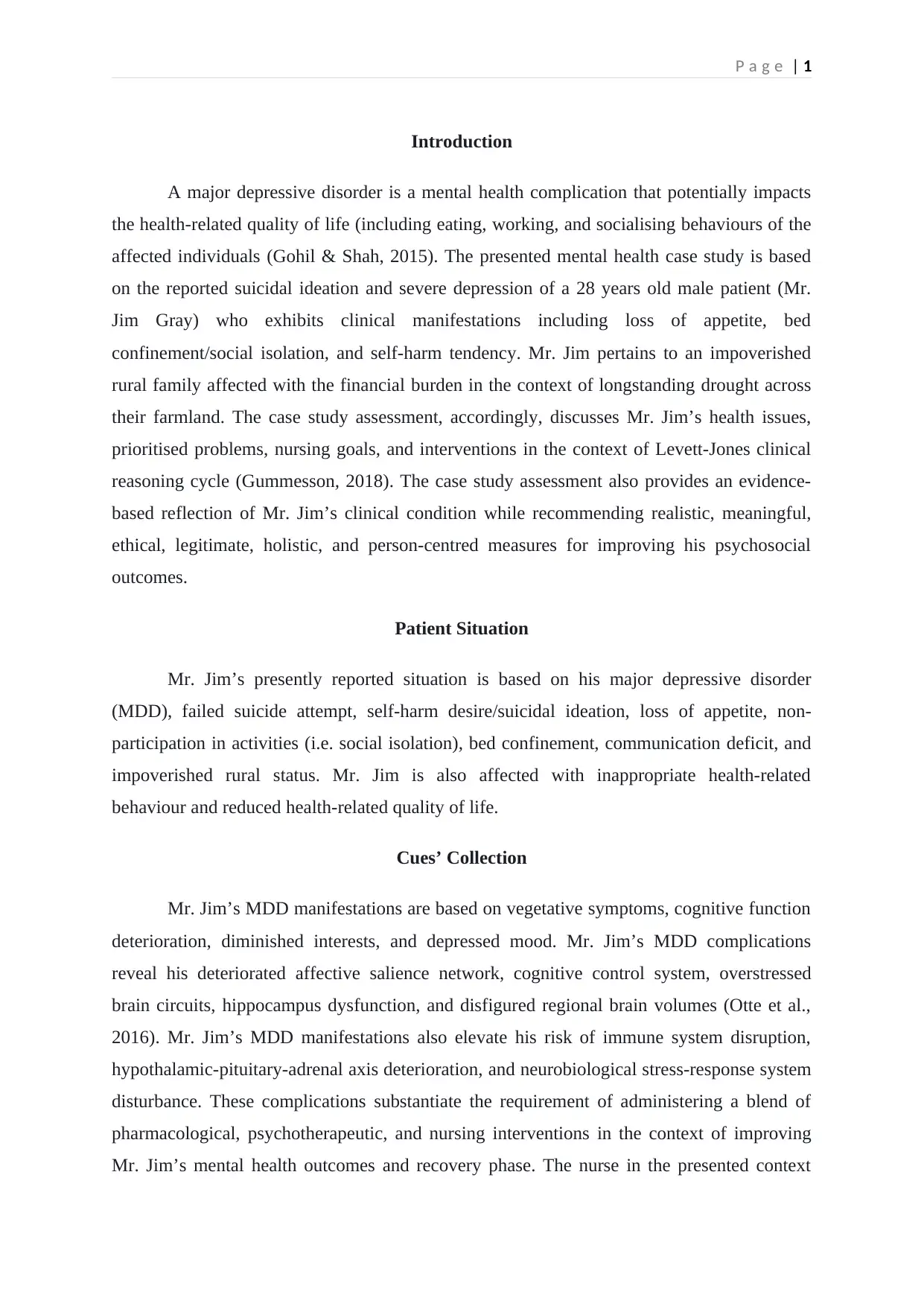
P a g e | 1
Introduction
A major depressive disorder is a mental health complication that potentially impacts
the health-related quality of life (including eating, working, and socialising behaviours of the
affected individuals (Gohil & Shah, 2015). The presented mental health case study is based
on the reported suicidal ideation and severe depression of a 28 years old male patient (Mr.
Jim Gray) who exhibits clinical manifestations including loss of appetite, bed
confinement/social isolation, and self-harm tendency. Mr. Jim pertains to an impoverished
rural family affected with the financial burden in the context of longstanding drought across
their farmland. The case study assessment, accordingly, discusses Mr. Jim’s health issues,
prioritised problems, nursing goals, and interventions in the context of Levett-Jones clinical
reasoning cycle (Gummesson, 2018). The case study assessment also provides an evidence-
based reflection of Mr. Jim’s clinical condition while recommending realistic, meaningful,
ethical, legitimate, holistic, and person-centred measures for improving his psychosocial
outcomes.
Patient Situation
Mr. Jim’s presently reported situation is based on his major depressive disorder
(MDD), failed suicide attempt, self-harm desire/suicidal ideation, loss of appetite, non-
participation in activities (i.e. social isolation), bed confinement, communication deficit, and
impoverished rural status. Mr. Jim is also affected with inappropriate health-related
behaviour and reduced health-related quality of life.
Cues’ Collection
Mr. Jim’s MDD manifestations are based on vegetative symptoms, cognitive function
deterioration, diminished interests, and depressed mood. Mr. Jim’s MDD complications
reveal his deteriorated affective salience network, cognitive control system, overstressed
brain circuits, hippocampus dysfunction, and disfigured regional brain volumes (Otte et al.,
2016). Mr. Jim’s MDD manifestations also elevate his risk of immune system disruption,
hypothalamic-pituitary-adrenal axis deterioration, and neurobiological stress-response system
disturbance. These complications substantiate the requirement of administering a blend of
pharmacological, psychotherapeutic, and nursing interventions in the context of improving
Mr. Jim’s mental health outcomes and recovery phase. The nurse in the presented context
Introduction
A major depressive disorder is a mental health complication that potentially impacts
the health-related quality of life (including eating, working, and socialising behaviours of the
affected individuals (Gohil & Shah, 2015). The presented mental health case study is based
on the reported suicidal ideation and severe depression of a 28 years old male patient (Mr.
Jim Gray) who exhibits clinical manifestations including loss of appetite, bed
confinement/social isolation, and self-harm tendency. Mr. Jim pertains to an impoverished
rural family affected with the financial burden in the context of longstanding drought across
their farmland. The case study assessment, accordingly, discusses Mr. Jim’s health issues,
prioritised problems, nursing goals, and interventions in the context of Levett-Jones clinical
reasoning cycle (Gummesson, 2018). The case study assessment also provides an evidence-
based reflection of Mr. Jim’s clinical condition while recommending realistic, meaningful,
ethical, legitimate, holistic, and person-centred measures for improving his psychosocial
outcomes.
Patient Situation
Mr. Jim’s presently reported situation is based on his major depressive disorder
(MDD), failed suicide attempt, self-harm desire/suicidal ideation, loss of appetite, non-
participation in activities (i.e. social isolation), bed confinement, communication deficit, and
impoverished rural status. Mr. Jim is also affected with inappropriate health-related
behaviour and reduced health-related quality of life.
Cues’ Collection
Mr. Jim’s MDD manifestations are based on vegetative symptoms, cognitive function
deterioration, diminished interests, and depressed mood. Mr. Jim’s MDD complications
reveal his deteriorated affective salience network, cognitive control system, overstressed
brain circuits, hippocampus dysfunction, and disfigured regional brain volumes (Otte et al.,
2016). Mr. Jim’s MDD manifestations also elevate his risk of immune system disruption,
hypothalamic-pituitary-adrenal axis deterioration, and neurobiological stress-response system
disturbance. These complications substantiate the requirement of administering a blend of
pharmacological, psychotherapeutic, and nursing interventions in the context of improving
Mr. Jim’s mental health outcomes and recovery phase. The nurse in the presented context
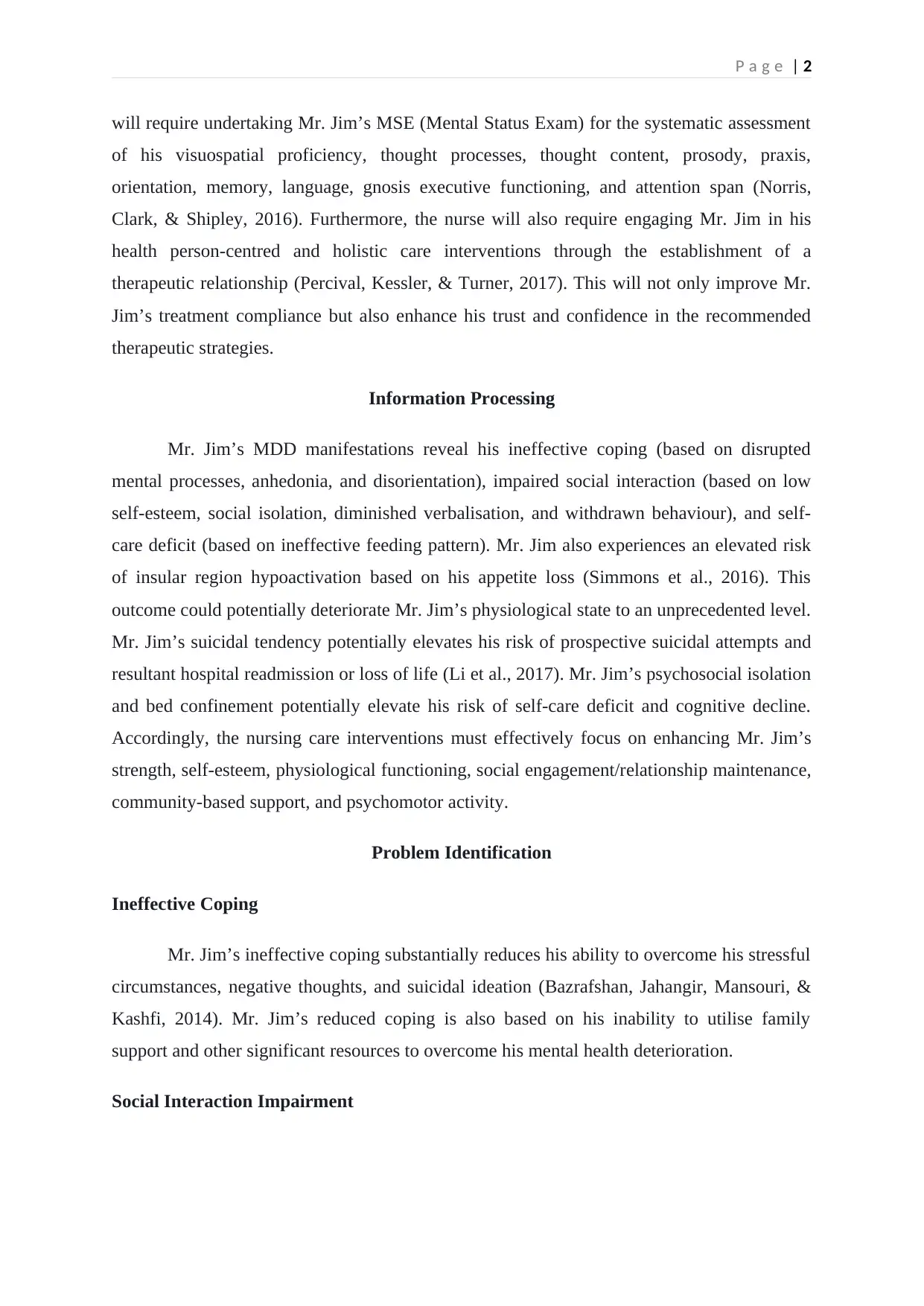
P a g e | 2
will require undertaking Mr. Jim’s MSE (Mental Status Exam) for the systematic assessment
of his visuospatial proficiency, thought processes, thought content, prosody, praxis,
orientation, memory, language, gnosis executive functioning, and attention span (Norris,
Clark, & Shipley, 2016). Furthermore, the nurse will also require engaging Mr. Jim in his
health person-centred and holistic care interventions through the establishment of a
therapeutic relationship (Percival, Kessler, & Turner, 2017). This will not only improve Mr.
Jim’s treatment compliance but also enhance his trust and confidence in the recommended
therapeutic strategies.
Information Processing
Mr. Jim’s MDD manifestations reveal his ineffective coping (based on disrupted
mental processes, anhedonia, and disorientation), impaired social interaction (based on low
self-esteem, social isolation, diminished verbalisation, and withdrawn behaviour), and self-
care deficit (based on ineffective feeding pattern). Mr. Jim also experiences an elevated risk
of insular region hypoactivation based on his appetite loss (Simmons et al., 2016). This
outcome could potentially deteriorate Mr. Jim’s physiological state to an unprecedented level.
Mr. Jim’s suicidal tendency potentially elevates his risk of prospective suicidal attempts and
resultant hospital readmission or loss of life (Li et al., 2017). Mr. Jim’s psychosocial isolation
and bed confinement potentially elevate his risk of self-care deficit and cognitive decline.
Accordingly, the nursing care interventions must effectively focus on enhancing Mr. Jim’s
strength, self-esteem, physiological functioning, social engagement/relationship maintenance,
community-based support, and psychomotor activity.
Problem Identification
Ineffective Coping
Mr. Jim’s ineffective coping substantially reduces his ability to overcome his stressful
circumstances, negative thoughts, and suicidal ideation (Bazrafshan, Jahangir, Mansouri, &
Kashfi, 2014). Mr. Jim’s reduced coping is also based on his inability to utilise family
support and other significant resources to overcome his mental health deterioration.
Social Interaction Impairment
will require undertaking Mr. Jim’s MSE (Mental Status Exam) for the systematic assessment
of his visuospatial proficiency, thought processes, thought content, prosody, praxis,
orientation, memory, language, gnosis executive functioning, and attention span (Norris,
Clark, & Shipley, 2016). Furthermore, the nurse will also require engaging Mr. Jim in his
health person-centred and holistic care interventions through the establishment of a
therapeutic relationship (Percival, Kessler, & Turner, 2017). This will not only improve Mr.
Jim’s treatment compliance but also enhance his trust and confidence in the recommended
therapeutic strategies.
Information Processing
Mr. Jim’s MDD manifestations reveal his ineffective coping (based on disrupted
mental processes, anhedonia, and disorientation), impaired social interaction (based on low
self-esteem, social isolation, diminished verbalisation, and withdrawn behaviour), and self-
care deficit (based on ineffective feeding pattern). Mr. Jim also experiences an elevated risk
of insular region hypoactivation based on his appetite loss (Simmons et al., 2016). This
outcome could potentially deteriorate Mr. Jim’s physiological state to an unprecedented level.
Mr. Jim’s suicidal tendency potentially elevates his risk of prospective suicidal attempts and
resultant hospital readmission or loss of life (Li et al., 2017). Mr. Jim’s psychosocial isolation
and bed confinement potentially elevate his risk of self-care deficit and cognitive decline.
Accordingly, the nursing care interventions must effectively focus on enhancing Mr. Jim’s
strength, self-esteem, physiological functioning, social engagement/relationship maintenance,
community-based support, and psychomotor activity.
Problem Identification
Ineffective Coping
Mr. Jim’s ineffective coping substantially reduces his ability to overcome his stressful
circumstances, negative thoughts, and suicidal ideation (Bazrafshan, Jahangir, Mansouri, &
Kashfi, 2014). Mr. Jim’s reduced coping is also based on his inability to utilise family
support and other significant resources to overcome his mental health deterioration.
Social Interaction Impairment
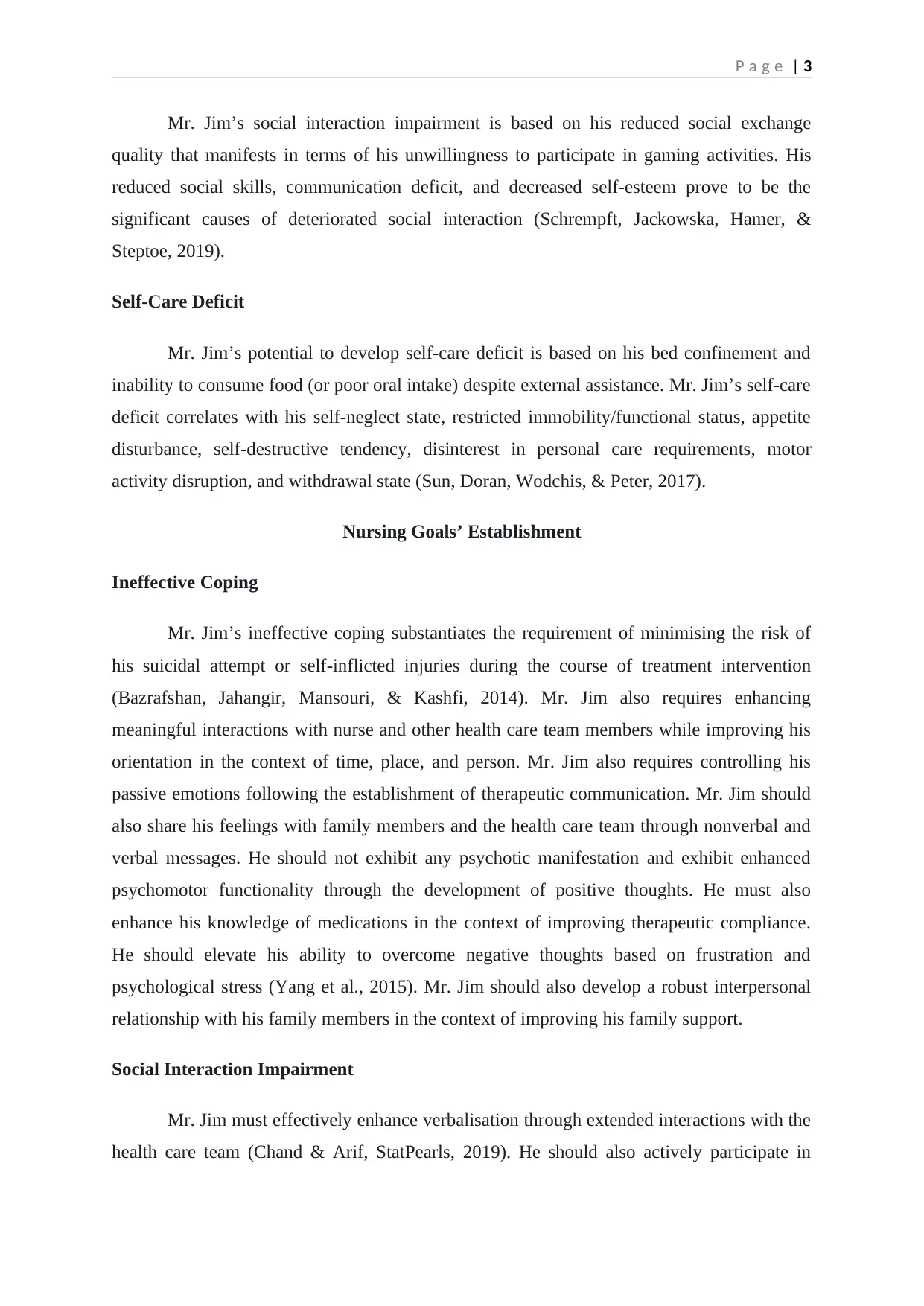
P a g e | 3
Mr. Jim’s social interaction impairment is based on his reduced social exchange
quality that manifests in terms of his unwillingness to participate in gaming activities. His
reduced social skills, communication deficit, and decreased self-esteem prove to be the
significant causes of deteriorated social interaction (Schrempft, Jackowska, Hamer, &
Steptoe, 2019).
Self-Care Deficit
Mr. Jim’s potential to develop self-care deficit is based on his bed confinement and
inability to consume food (or poor oral intake) despite external assistance. Mr. Jim’s self-care
deficit correlates with his self-neglect state, restricted immobility/functional status, appetite
disturbance, self-destructive tendency, disinterest in personal care requirements, motor
activity disruption, and withdrawal state (Sun, Doran, Wodchis, & Peter, 2017).
Nursing Goals’ Establishment
Ineffective Coping
Mr. Jim’s ineffective coping substantiates the requirement of minimising the risk of
his suicidal attempt or self-inflicted injuries during the course of treatment intervention
(Bazrafshan, Jahangir, Mansouri, & Kashfi, 2014). Mr. Jim also requires enhancing
meaningful interactions with nurse and other health care team members while improving his
orientation in the context of time, place, and person. Mr. Jim also requires controlling his
passive emotions following the establishment of therapeutic communication. Mr. Jim should
also share his feelings with family members and the health care team through nonverbal and
verbal messages. He should not exhibit any psychotic manifestation and exhibit enhanced
psychomotor functionality through the development of positive thoughts. He must also
enhance his knowledge of medications in the context of improving therapeutic compliance.
He should elevate his ability to overcome negative thoughts based on frustration and
psychological stress (Yang et al., 2015). Mr. Jim should also develop a robust interpersonal
relationship with his family members in the context of improving his family support.
Social Interaction Impairment
Mr. Jim must effectively enhance verbalisation through extended interactions with the
health care team (Chand & Arif, StatPearls, 2019). He should also actively participate in
Mr. Jim’s social interaction impairment is based on his reduced social exchange
quality that manifests in terms of his unwillingness to participate in gaming activities. His
reduced social skills, communication deficit, and decreased self-esteem prove to be the
significant causes of deteriorated social interaction (Schrempft, Jackowska, Hamer, &
Steptoe, 2019).
Self-Care Deficit
Mr. Jim’s potential to develop self-care deficit is based on his bed confinement and
inability to consume food (or poor oral intake) despite external assistance. Mr. Jim’s self-care
deficit correlates with his self-neglect state, restricted immobility/functional status, appetite
disturbance, self-destructive tendency, disinterest in personal care requirements, motor
activity disruption, and withdrawal state (Sun, Doran, Wodchis, & Peter, 2017).
Nursing Goals’ Establishment
Ineffective Coping
Mr. Jim’s ineffective coping substantiates the requirement of minimising the risk of
his suicidal attempt or self-inflicted injuries during the course of treatment intervention
(Bazrafshan, Jahangir, Mansouri, & Kashfi, 2014). Mr. Jim also requires enhancing
meaningful interactions with nurse and other health care team members while improving his
orientation in the context of time, place, and person. Mr. Jim also requires controlling his
passive emotions following the establishment of therapeutic communication. Mr. Jim should
also share his feelings with family members and the health care team through nonverbal and
verbal messages. He should not exhibit any psychotic manifestation and exhibit enhanced
psychomotor functionality through the development of positive thoughts. He must also
enhance his knowledge of medications in the context of improving therapeutic compliance.
He should elevate his ability to overcome negative thoughts based on frustration and
psychological stress (Yang et al., 2015). Mr. Jim should also develop a robust interpersonal
relationship with his family members in the context of improving his family support.
Social Interaction Impairment
Mr. Jim must effectively enhance verbalisation through extended interactions with the
health care team (Chand & Arif, StatPearls, 2019). He should also actively participate in
Secure Best Marks with AI Grader
Need help grading? Try our AI Grader for instant feedback on your assignments.
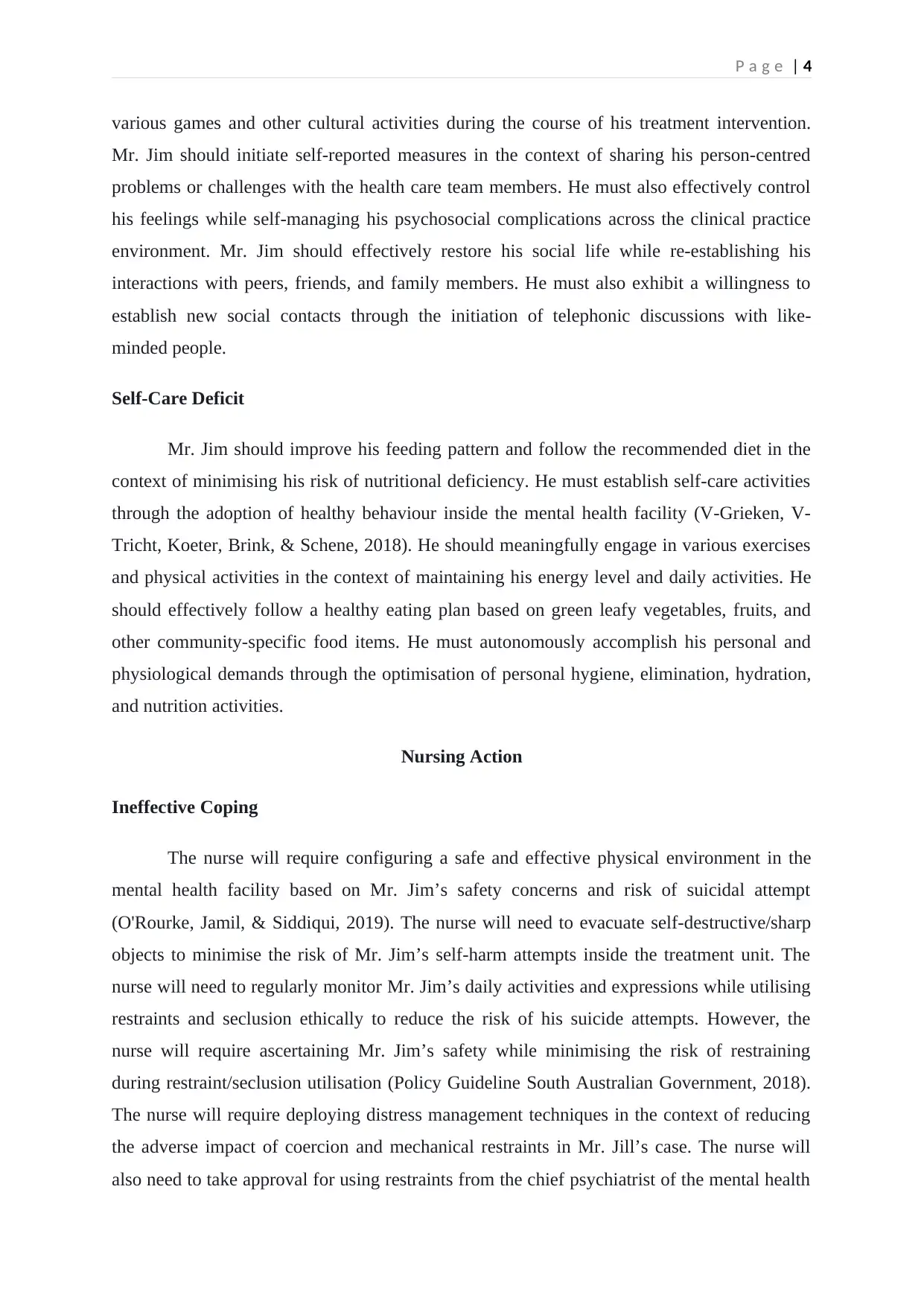
P a g e | 4
various games and other cultural activities during the course of his treatment intervention.
Mr. Jim should initiate self-reported measures in the context of sharing his person-centred
problems or challenges with the health care team members. He must also effectively control
his feelings while self-managing his psychosocial complications across the clinical practice
environment. Mr. Jim should effectively restore his social life while re-establishing his
interactions with peers, friends, and family members. He must also exhibit a willingness to
establish new social contacts through the initiation of telephonic discussions with like-
minded people.
Self-Care Deficit
Mr. Jim should improve his feeding pattern and follow the recommended diet in the
context of minimising his risk of nutritional deficiency. He must establish self-care activities
through the adoption of healthy behaviour inside the mental health facility (V-Grieken, V-
Tricht, Koeter, Brink, & Schene, 2018). He should meaningfully engage in various exercises
and physical activities in the context of maintaining his energy level and daily activities. He
should effectively follow a healthy eating plan based on green leafy vegetables, fruits, and
other community-specific food items. He must autonomously accomplish his personal and
physiological demands through the optimisation of personal hygiene, elimination, hydration,
and nutrition activities.
Nursing Action
Ineffective Coping
The nurse will require configuring a safe and effective physical environment in the
mental health facility based on Mr. Jim’s safety concerns and risk of suicidal attempt
(O'Rourke, Jamil, & Siddiqui, 2019). The nurse will need to evacuate self-destructive/sharp
objects to minimise the risk of Mr. Jim’s self-harm attempts inside the treatment unit. The
nurse will need to regularly monitor Mr. Jim’s daily activities and expressions while utilising
restraints and seclusion ethically to reduce the risk of his suicide attempts. However, the
nurse will require ascertaining Mr. Jim’s safety while minimising the risk of restraining
during restraint/seclusion utilisation (Policy Guideline South Australian Government, 2018).
The nurse will require deploying distress management techniques in the context of reducing
the adverse impact of coercion and mechanical restraints in Mr. Jill’s case. The nurse will
also need to take approval for using restraints from the chief psychiatrist of the mental health
various games and other cultural activities during the course of his treatment intervention.
Mr. Jim should initiate self-reported measures in the context of sharing his person-centred
problems or challenges with the health care team members. He must also effectively control
his feelings while self-managing his psychosocial complications across the clinical practice
environment. Mr. Jim should effectively restore his social life while re-establishing his
interactions with peers, friends, and family members. He must also exhibit a willingness to
establish new social contacts through the initiation of telephonic discussions with like-
minded people.
Self-Care Deficit
Mr. Jim should improve his feeding pattern and follow the recommended diet in the
context of minimising his risk of nutritional deficiency. He must establish self-care activities
through the adoption of healthy behaviour inside the mental health facility (V-Grieken, V-
Tricht, Koeter, Brink, & Schene, 2018). He should meaningfully engage in various exercises
and physical activities in the context of maintaining his energy level and daily activities. He
should effectively follow a healthy eating plan based on green leafy vegetables, fruits, and
other community-specific food items. He must autonomously accomplish his personal and
physiological demands through the optimisation of personal hygiene, elimination, hydration,
and nutrition activities.
Nursing Action
Ineffective Coping
The nurse will require configuring a safe and effective physical environment in the
mental health facility based on Mr. Jim’s safety concerns and risk of suicidal attempt
(O'Rourke, Jamil, & Siddiqui, 2019). The nurse will need to evacuate self-destructive/sharp
objects to minimise the risk of Mr. Jim’s self-harm attempts inside the treatment unit. The
nurse will need to regularly monitor Mr. Jim’s daily activities and expressions while utilising
restraints and seclusion ethically to reduce the risk of his suicide attempts. However, the
nurse will require ascertaining Mr. Jim’s safety while minimising the risk of restraining
during restraint/seclusion utilisation (Policy Guideline South Australian Government, 2018).
The nurse will require deploying distress management techniques in the context of reducing
the adverse impact of coercion and mechanical restraints in Mr. Jill’s case. The nurse will
also need to take approval for using restraints from the chief psychiatrist of the mental health
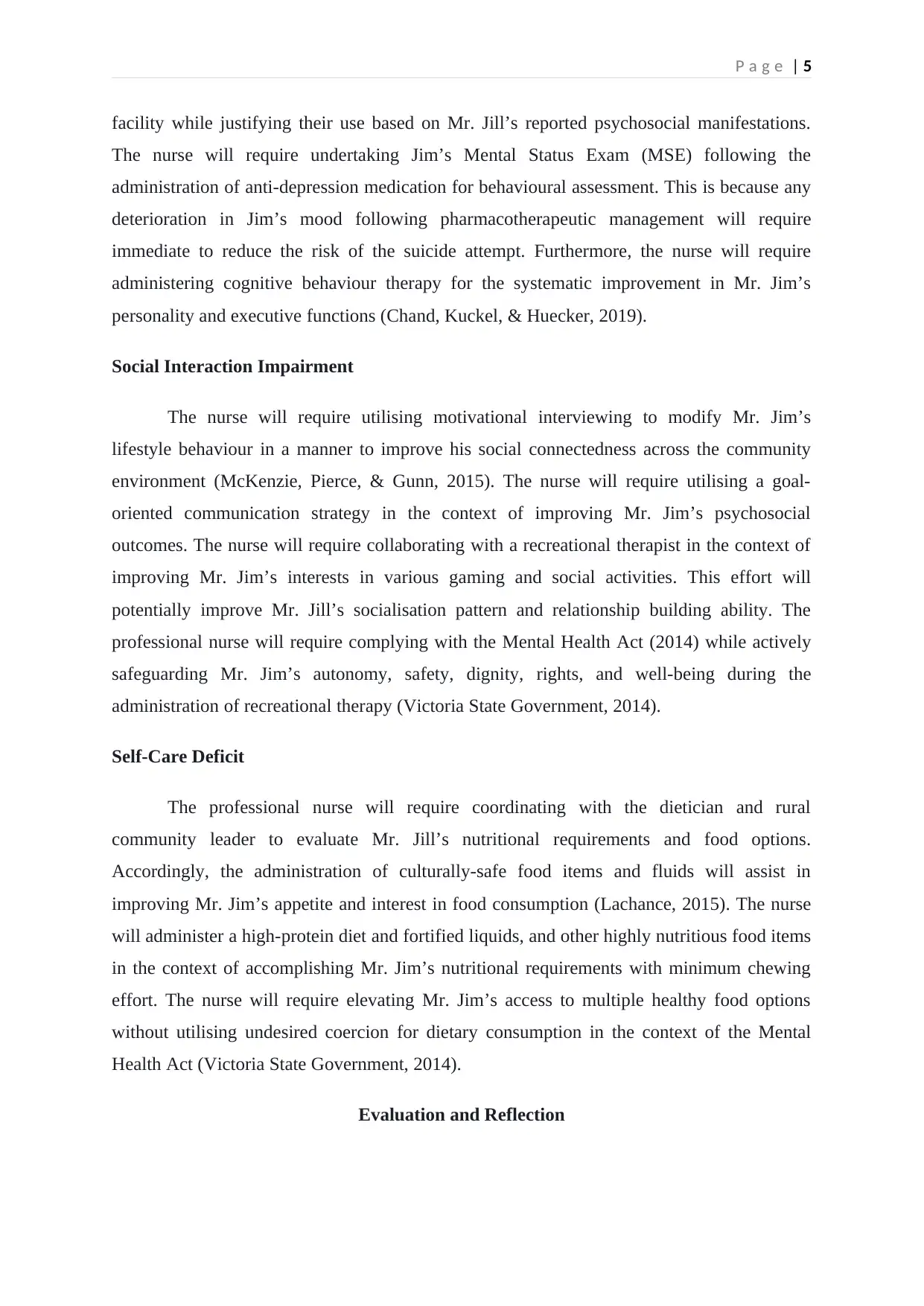
P a g e | 5
facility while justifying their use based on Mr. Jill’s reported psychosocial manifestations.
The nurse will require undertaking Jim’s Mental Status Exam (MSE) following the
administration of anti-depression medication for behavioural assessment. This is because any
deterioration in Jim’s mood following pharmacotherapeutic management will require
immediate to reduce the risk of the suicide attempt. Furthermore, the nurse will require
administering cognitive behaviour therapy for the systematic improvement in Mr. Jim’s
personality and executive functions (Chand, Kuckel, & Huecker, 2019).
Social Interaction Impairment
The nurse will require utilising motivational interviewing to modify Mr. Jim’s
lifestyle behaviour in a manner to improve his social connectedness across the community
environment (McKenzie, Pierce, & Gunn, 2015). The nurse will require utilising a goal-
oriented communication strategy in the context of improving Mr. Jim’s psychosocial
outcomes. The nurse will require collaborating with a recreational therapist in the context of
improving Mr. Jim’s interests in various gaming and social activities. This effort will
potentially improve Mr. Jill’s socialisation pattern and relationship building ability. The
professional nurse will require complying with the Mental Health Act (2014) while actively
safeguarding Mr. Jim’s autonomy, safety, dignity, rights, and well-being during the
administration of recreational therapy (Victoria State Government, 2014).
Self-Care Deficit
The professional nurse will require coordinating with the dietician and rural
community leader to evaluate Mr. Jill’s nutritional requirements and food options.
Accordingly, the administration of culturally-safe food items and fluids will assist in
improving Mr. Jim’s appetite and interest in food consumption (Lachance, 2015). The nurse
will administer a high-protein diet and fortified liquids, and other highly nutritious food items
in the context of accomplishing Mr. Jim’s nutritional requirements with minimum chewing
effort. The nurse will require elevating Mr. Jim’s access to multiple healthy food options
without utilising undesired coercion for dietary consumption in the context of the Mental
Health Act (Victoria State Government, 2014).
Evaluation and Reflection
facility while justifying their use based on Mr. Jill’s reported psychosocial manifestations.
The nurse will require undertaking Jim’s Mental Status Exam (MSE) following the
administration of anti-depression medication for behavioural assessment. This is because any
deterioration in Jim’s mood following pharmacotherapeutic management will require
immediate to reduce the risk of the suicide attempt. Furthermore, the nurse will require
administering cognitive behaviour therapy for the systematic improvement in Mr. Jim’s
personality and executive functions (Chand, Kuckel, & Huecker, 2019).
Social Interaction Impairment
The nurse will require utilising motivational interviewing to modify Mr. Jim’s
lifestyle behaviour in a manner to improve his social connectedness across the community
environment (McKenzie, Pierce, & Gunn, 2015). The nurse will require utilising a goal-
oriented communication strategy in the context of improving Mr. Jim’s psychosocial
outcomes. The nurse will require collaborating with a recreational therapist in the context of
improving Mr. Jim’s interests in various gaming and social activities. This effort will
potentially improve Mr. Jill’s socialisation pattern and relationship building ability. The
professional nurse will require complying with the Mental Health Act (2014) while actively
safeguarding Mr. Jim’s autonomy, safety, dignity, rights, and well-being during the
administration of recreational therapy (Victoria State Government, 2014).
Self-Care Deficit
The professional nurse will require coordinating with the dietician and rural
community leader to evaluate Mr. Jill’s nutritional requirements and food options.
Accordingly, the administration of culturally-safe food items and fluids will assist in
improving Mr. Jim’s appetite and interest in food consumption (Lachance, 2015). The nurse
will administer a high-protein diet and fortified liquids, and other highly nutritious food items
in the context of accomplishing Mr. Jim’s nutritional requirements with minimum chewing
effort. The nurse will require elevating Mr. Jim’s access to multiple healthy food options
without utilising undesired coercion for dietary consumption in the context of the Mental
Health Act (Victoria State Government, 2014).
Evaluation and Reflection
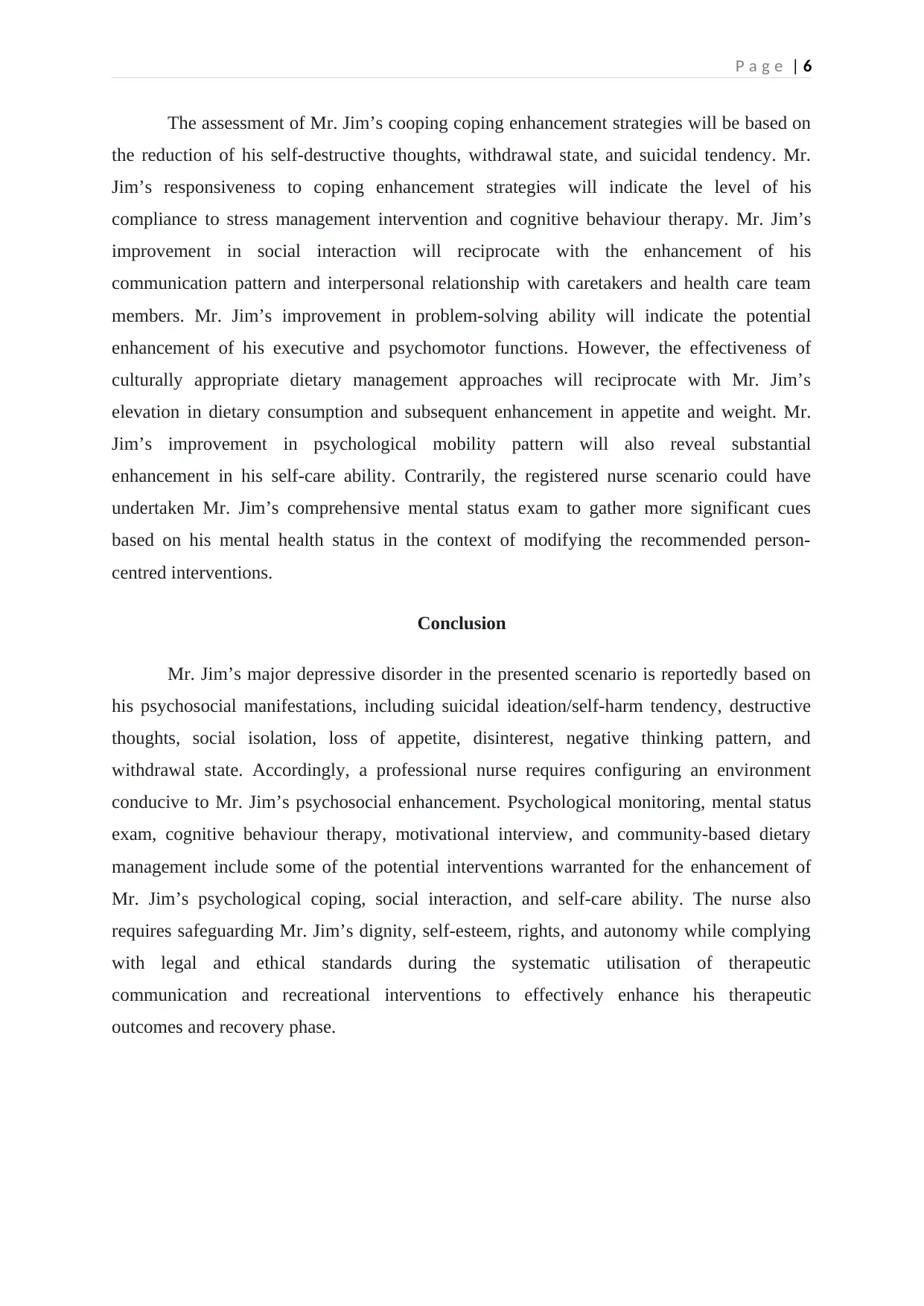
P a g e | 6
The assessment of Mr. Jim’s cooping coping enhancement strategies will be based on
the reduction of his self-destructive thoughts, withdrawal state, and suicidal tendency. Mr.
Jim’s responsiveness to coping enhancement strategies will indicate the level of his
compliance to stress management intervention and cognitive behaviour therapy. Mr. Jim’s
improvement in social interaction will reciprocate with the enhancement of his
communication pattern and interpersonal relationship with caretakers and health care team
members. Mr. Jim’s improvement in problem-solving ability will indicate the potential
enhancement of his executive and psychomotor functions. However, the effectiveness of
culturally appropriate dietary management approaches will reciprocate with Mr. Jim’s
elevation in dietary consumption and subsequent enhancement in appetite and weight. Mr.
Jim’s improvement in psychological mobility pattern will also reveal substantial
enhancement in his self-care ability. Contrarily, the registered nurse scenario could have
undertaken Mr. Jim’s comprehensive mental status exam to gather more significant cues
based on his mental health status in the context of modifying the recommended person-
centred interventions.
Conclusion
Mr. Jim’s major depressive disorder in the presented scenario is reportedly based on
his psychosocial manifestations, including suicidal ideation/self-harm tendency, destructive
thoughts, social isolation, loss of appetite, disinterest, negative thinking pattern, and
withdrawal state. Accordingly, a professional nurse requires configuring an environment
conducive to Mr. Jim’s psychosocial enhancement. Psychological monitoring, mental status
exam, cognitive behaviour therapy, motivational interview, and community-based dietary
management include some of the potential interventions warranted for the enhancement of
Mr. Jim’s psychological coping, social interaction, and self-care ability. The nurse also
requires safeguarding Mr. Jim’s dignity, self-esteem, rights, and autonomy while complying
with legal and ethical standards during the systematic utilisation of therapeutic
communication and recreational interventions to effectively enhance his therapeutic
outcomes and recovery phase.
The assessment of Mr. Jim’s cooping coping enhancement strategies will be based on
the reduction of his self-destructive thoughts, withdrawal state, and suicidal tendency. Mr.
Jim’s responsiveness to coping enhancement strategies will indicate the level of his
compliance to stress management intervention and cognitive behaviour therapy. Mr. Jim’s
improvement in social interaction will reciprocate with the enhancement of his
communication pattern and interpersonal relationship with caretakers and health care team
members. Mr. Jim’s improvement in problem-solving ability will indicate the potential
enhancement of his executive and psychomotor functions. However, the effectiveness of
culturally appropriate dietary management approaches will reciprocate with Mr. Jim’s
elevation in dietary consumption and subsequent enhancement in appetite and weight. Mr.
Jim’s improvement in psychological mobility pattern will also reveal substantial
enhancement in his self-care ability. Contrarily, the registered nurse scenario could have
undertaken Mr. Jim’s comprehensive mental status exam to gather more significant cues
based on his mental health status in the context of modifying the recommended person-
centred interventions.
Conclusion
Mr. Jim’s major depressive disorder in the presented scenario is reportedly based on
his psychosocial manifestations, including suicidal ideation/self-harm tendency, destructive
thoughts, social isolation, loss of appetite, disinterest, negative thinking pattern, and
withdrawal state. Accordingly, a professional nurse requires configuring an environment
conducive to Mr. Jim’s psychosocial enhancement. Psychological monitoring, mental status
exam, cognitive behaviour therapy, motivational interview, and community-based dietary
management include some of the potential interventions warranted for the enhancement of
Mr. Jim’s psychological coping, social interaction, and self-care ability. The nurse also
requires safeguarding Mr. Jim’s dignity, self-esteem, rights, and autonomy while complying
with legal and ethical standards during the systematic utilisation of therapeutic
communication and recreational interventions to effectively enhance his therapeutic
outcomes and recovery phase.
Paraphrase This Document
Need a fresh take? Get an instant paraphrase of this document with our AI Paraphraser
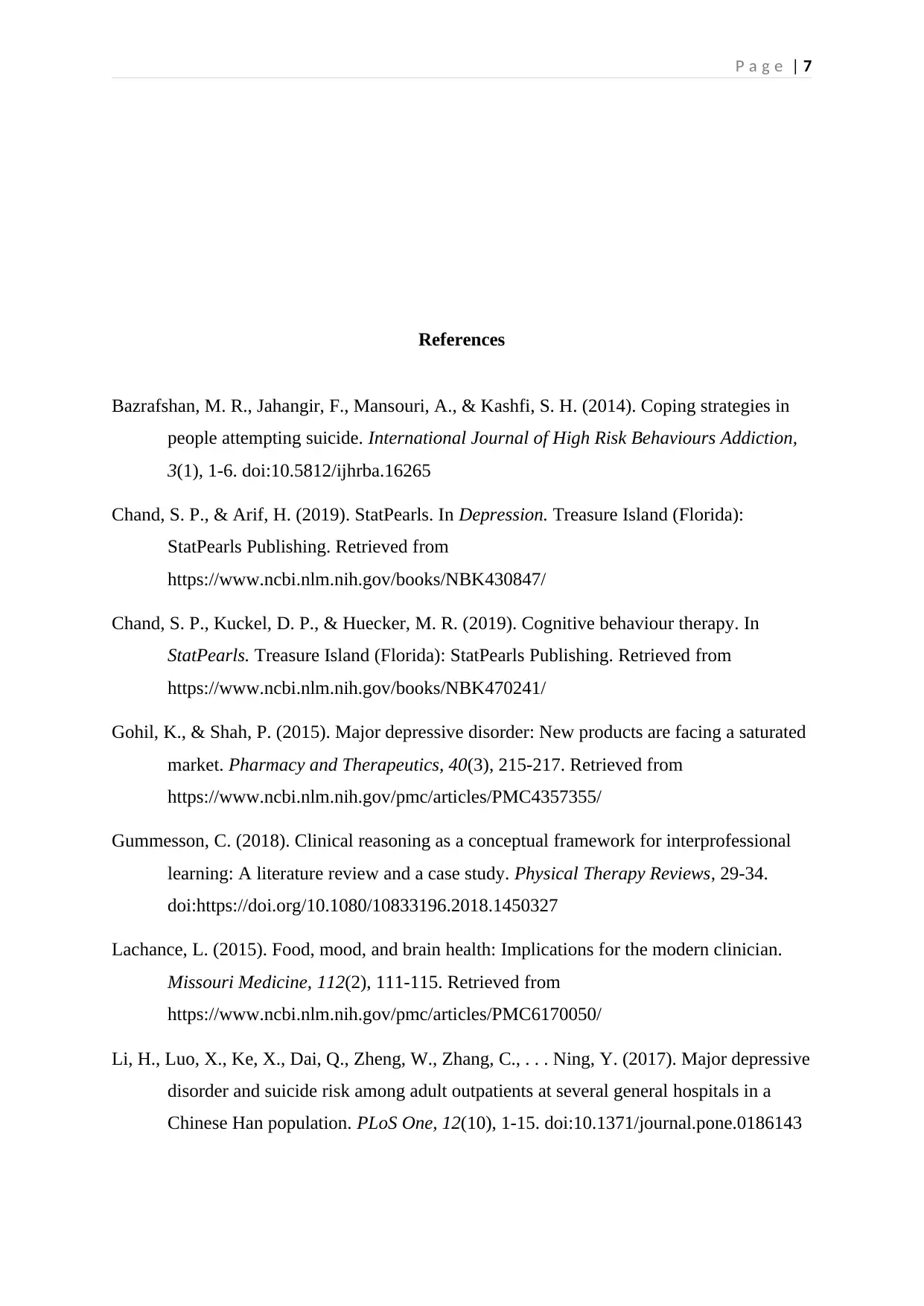
P a g e | 7
References
Bazrafshan, M. R., Jahangir, F., Mansouri, A., & Kashfi, S. H. (2014). Coping strategies in
people attempting suicide. International Journal of High Risk Behaviours Addiction,
3(1), 1-6. doi:10.5812/ijhrba.16265
Chand, S. P., & Arif, H. (2019). StatPearls. In Depression. Treasure Island (Florida):
StatPearls Publishing. Retrieved from
https://www.ncbi.nlm.nih.gov/books/NBK430847/
Chand, S. P., Kuckel, D. P., & Huecker, M. R. (2019). Cognitive behaviour therapy. In
StatPearls. Treasure Island (Florida): StatPearls Publishing. Retrieved from
https://www.ncbi.nlm.nih.gov/books/NBK470241/
Gohil, K., & Shah, P. (2015). Major depressive disorder: New products are facing a saturated
market. Pharmacy and Therapeutics, 40(3), 215-217. Retrieved from
https://www.ncbi.nlm.nih.gov/pmc/articles/PMC4357355/
Gummesson, C. (2018). Clinical reasoning as a conceptual framework for interprofessional
learning: A literature review and a case study. Physical Therapy Reviews, 29-34.
doi:https://doi.org/10.1080/10833196.2018.1450327
Lachance, L. (2015). Food, mood, and brain health: Implications for the modern clinician.
Missouri Medicine, 112(2), 111-115. Retrieved from
https://www.ncbi.nlm.nih.gov/pmc/articles/PMC6170050/
Li, H., Luo, X., Ke, X., Dai, Q., Zheng, W., Zhang, C., . . . Ning, Y. (2017). Major depressive
disorder and suicide risk among adult outpatients at several general hospitals in a
Chinese Han population. PLoS One, 12(10), 1-15. doi:10.1371/journal.pone.0186143
References
Bazrafshan, M. R., Jahangir, F., Mansouri, A., & Kashfi, S. H. (2014). Coping strategies in
people attempting suicide. International Journal of High Risk Behaviours Addiction,
3(1), 1-6. doi:10.5812/ijhrba.16265
Chand, S. P., & Arif, H. (2019). StatPearls. In Depression. Treasure Island (Florida):
StatPearls Publishing. Retrieved from
https://www.ncbi.nlm.nih.gov/books/NBK430847/
Chand, S. P., Kuckel, D. P., & Huecker, M. R. (2019). Cognitive behaviour therapy. In
StatPearls. Treasure Island (Florida): StatPearls Publishing. Retrieved from
https://www.ncbi.nlm.nih.gov/books/NBK470241/
Gohil, K., & Shah, P. (2015). Major depressive disorder: New products are facing a saturated
market. Pharmacy and Therapeutics, 40(3), 215-217. Retrieved from
https://www.ncbi.nlm.nih.gov/pmc/articles/PMC4357355/
Gummesson, C. (2018). Clinical reasoning as a conceptual framework for interprofessional
learning: A literature review and a case study. Physical Therapy Reviews, 29-34.
doi:https://doi.org/10.1080/10833196.2018.1450327
Lachance, L. (2015). Food, mood, and brain health: Implications for the modern clinician.
Missouri Medicine, 112(2), 111-115. Retrieved from
https://www.ncbi.nlm.nih.gov/pmc/articles/PMC6170050/
Li, H., Luo, X., Ke, X., Dai, Q., Zheng, W., Zhang, C., . . . Ning, Y. (2017). Major depressive
disorder and suicide risk among adult outpatients at several general hospitals in a
Chinese Han population. PLoS One, 12(10), 1-15. doi:10.1371/journal.pone.0186143
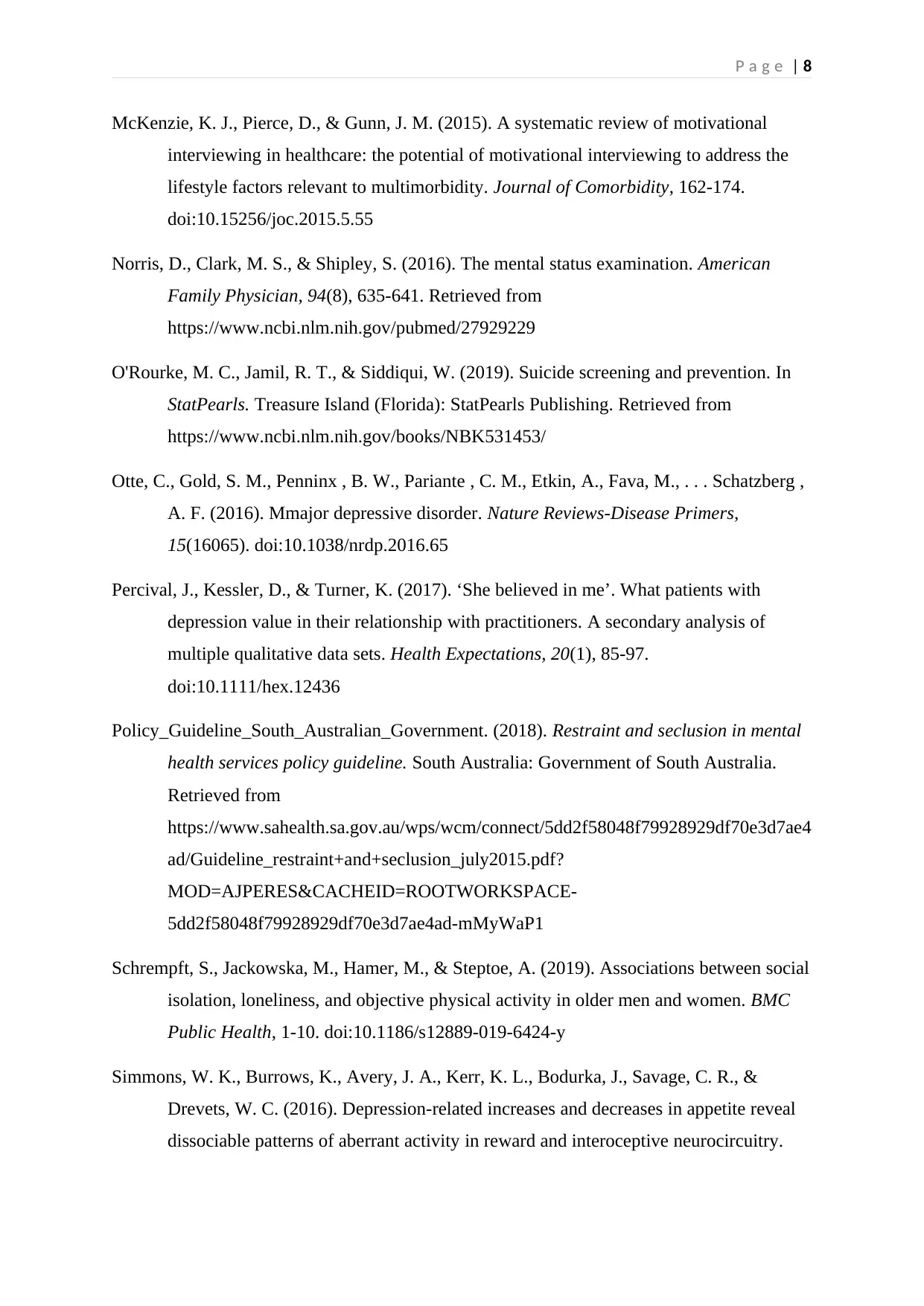
P a g e | 8
McKenzie, K. J., Pierce, D., & Gunn, J. M. (2015). A systematic review of motivational
interviewing in healthcare: the potential of motivational interviewing to address the
lifestyle factors relevant to multimorbidity. Journal of Comorbidity, 162-174.
doi:10.15256/joc.2015.5.55
Norris, D., Clark, M. S., & Shipley, S. (2016). The mental status examination. American
Family Physician, 94(8), 635-641. Retrieved from
https://www.ncbi.nlm.nih.gov/pubmed/27929229
O'Rourke, M. C., Jamil, R. T., & Siddiqui, W. (2019). Suicide screening and prevention. In
StatPearls. Treasure Island (Florida): StatPearls Publishing. Retrieved from
https://www.ncbi.nlm.nih.gov/books/NBK531453/
Otte, C., Gold, S. M., Penninx , B. W., Pariante , C. M., Etkin, A., Fava, M., . . . Schatzberg ,
A. F. (2016). Mmajor depressive disorder. Nature Reviews-Disease Primers,
15(16065). doi:10.1038/nrdp.2016.65
Percival, J., Kessler, D., & Turner, K. (2017). ‘She believed in me’. What patients with
depression value in their relationship with practitioners. A secondary analysis of
multiple qualitative data sets. Health Expectations, 20(1), 85-97.
doi:10.1111/hex.12436
Policy_Guideline_South_Australian_Government. (2018). Restraint and seclusion in mental
health services policy guideline. South Australia: Government of South Australia.
Retrieved from
https://www.sahealth.sa.gov.au/wps/wcm/connect/5dd2f58048f79928929df70e3d7ae4
ad/Guideline_restraint+and+seclusion_july2015.pdf?
MOD=AJPERES&CACHEID=ROOTWORKSPACE-
5dd2f58048f79928929df70e3d7ae4ad-mMyWaP1
Schrempft, S., Jackowska, M., Hamer, M., & Steptoe, A. (2019). Associations between social
isolation, loneliness, and objective physical activity in older men and women. BMC
Public Health, 1-10. doi:10.1186/s12889-019-6424-y
Simmons, W. K., Burrows, K., Avery, J. A., Kerr, K. L., Bodurka, J., Savage, C. R., &
Drevets, W. C. (2016). Depression-related increases and decreases in appetite reveal
dissociable patterns of aberrant activity in reward and interoceptive neurocircuitry.
McKenzie, K. J., Pierce, D., & Gunn, J. M. (2015). A systematic review of motivational
interviewing in healthcare: the potential of motivational interviewing to address the
lifestyle factors relevant to multimorbidity. Journal of Comorbidity, 162-174.
doi:10.15256/joc.2015.5.55
Norris, D., Clark, M. S., & Shipley, S. (2016). The mental status examination. American
Family Physician, 94(8), 635-641. Retrieved from
https://www.ncbi.nlm.nih.gov/pubmed/27929229
O'Rourke, M. C., Jamil, R. T., & Siddiqui, W. (2019). Suicide screening and prevention. In
StatPearls. Treasure Island (Florida): StatPearls Publishing. Retrieved from
https://www.ncbi.nlm.nih.gov/books/NBK531453/
Otte, C., Gold, S. M., Penninx , B. W., Pariante , C. M., Etkin, A., Fava, M., . . . Schatzberg ,
A. F. (2016). Mmajor depressive disorder. Nature Reviews-Disease Primers,
15(16065). doi:10.1038/nrdp.2016.65
Percival, J., Kessler, D., & Turner, K. (2017). ‘She believed in me’. What patients with
depression value in their relationship with practitioners. A secondary analysis of
multiple qualitative data sets. Health Expectations, 20(1), 85-97.
doi:10.1111/hex.12436
Policy_Guideline_South_Australian_Government. (2018). Restraint and seclusion in mental
health services policy guideline. South Australia: Government of South Australia.
Retrieved from
https://www.sahealth.sa.gov.au/wps/wcm/connect/5dd2f58048f79928929df70e3d7ae4
ad/Guideline_restraint+and+seclusion_july2015.pdf?
MOD=AJPERES&CACHEID=ROOTWORKSPACE-
5dd2f58048f79928929df70e3d7ae4ad-mMyWaP1
Schrempft, S., Jackowska, M., Hamer, M., & Steptoe, A. (2019). Associations between social
isolation, loneliness, and objective physical activity in older men and women. BMC
Public Health, 1-10. doi:10.1186/s12889-019-6424-y
Simmons, W. K., Burrows, K., Avery, J. A., Kerr, K. L., Bodurka, J., Savage, C. R., &
Drevets, W. C. (2016). Depression-related increases and decreases in appetite reveal
dissociable patterns of aberrant activity in reward and interoceptive neurocircuitry.
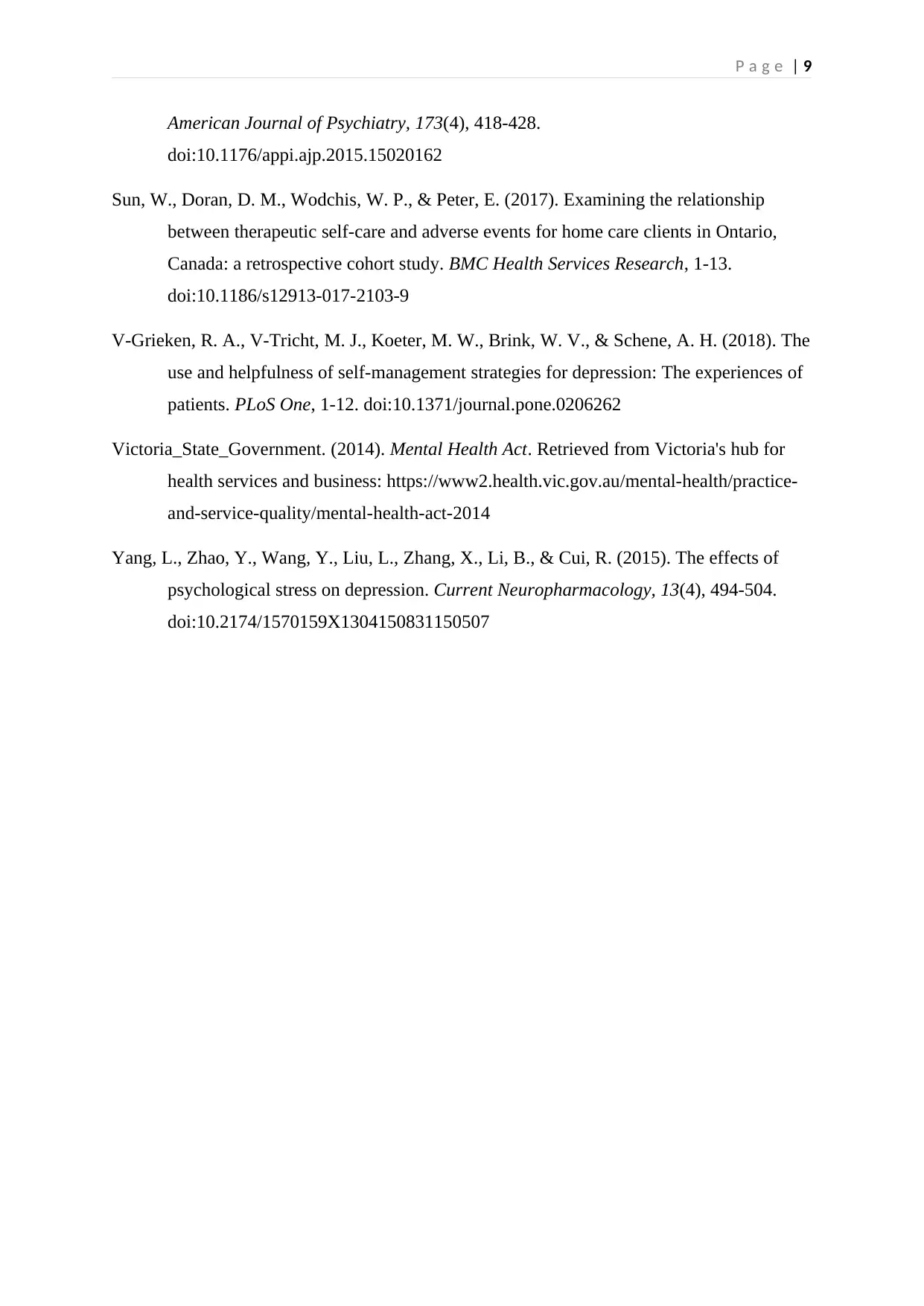
P a g e | 9
American Journal of Psychiatry, 173(4), 418-428.
doi:10.1176/appi.ajp.2015.15020162
Sun, W., Doran, D. M., Wodchis, W. P., & Peter, E. (2017). Examining the relationship
between therapeutic self-care and adverse events for home care clients in Ontario,
Canada: a retrospective cohort study. BMC Health Services Research, 1-13.
doi:10.1186/s12913-017-2103-9
V-Grieken, R. A., V-Tricht, M. J., Koeter, M. W., Brink, W. V., & Schene, A. H. (2018). The
use and helpfulness of self-management strategies for depression: The experiences of
patients. PLoS One, 1-12. doi:10.1371/journal.pone.0206262
Victoria_State_Government. (2014). Mental Health Act. Retrieved from Victoria's hub for
health services and business: https://www2.health.vic.gov.au/mental-health/practice-
and-service-quality/mental-health-act-2014
Yang, L., Zhao, Y., Wang, Y., Liu, L., Zhang, X., Li, B., & Cui, R. (2015). The effects of
psychological stress on depression. Current Neuropharmacology, 13(4), 494-504.
doi:10.2174/1570159X1304150831150507
American Journal of Psychiatry, 173(4), 418-428.
doi:10.1176/appi.ajp.2015.15020162
Sun, W., Doran, D. M., Wodchis, W. P., & Peter, E. (2017). Examining the relationship
between therapeutic self-care and adverse events for home care clients in Ontario,
Canada: a retrospective cohort study. BMC Health Services Research, 1-13.
doi:10.1186/s12913-017-2103-9
V-Grieken, R. A., V-Tricht, M. J., Koeter, M. W., Brink, W. V., & Schene, A. H. (2018). The
use and helpfulness of self-management strategies for depression: The experiences of
patients. PLoS One, 1-12. doi:10.1371/journal.pone.0206262
Victoria_State_Government. (2014). Mental Health Act. Retrieved from Victoria's hub for
health services and business: https://www2.health.vic.gov.au/mental-health/practice-
and-service-quality/mental-health-act-2014
Yang, L., Zhao, Y., Wang, Y., Liu, L., Zhang, X., Li, B., & Cui, R. (2015). The effects of
psychological stress on depression. Current Neuropharmacology, 13(4), 494-504.
doi:10.2174/1570159X1304150831150507
1 out of 10
Related Documents
Your All-in-One AI-Powered Toolkit for Academic Success.
+13062052269
info@desklib.com
Available 24*7 on WhatsApp / Email
![[object Object]](/_next/static/media/star-bottom.7253800d.svg)
Unlock your academic potential
© 2024 | Zucol Services PVT LTD | All rights reserved.





